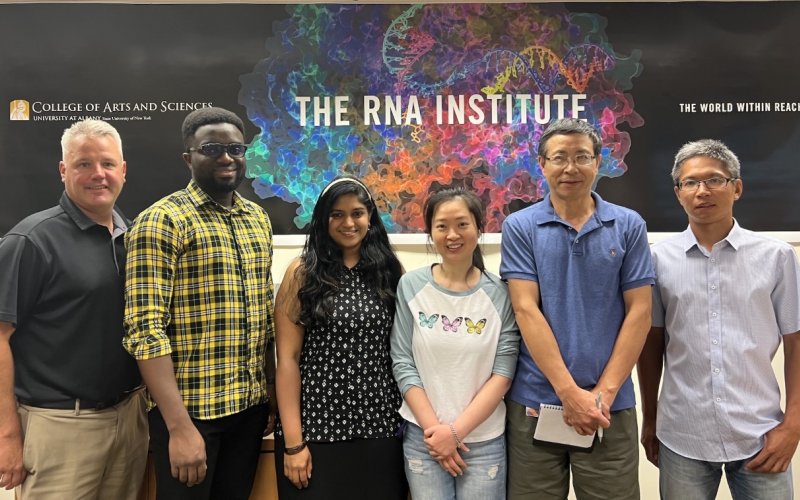UAlbany Researchers Awarded $1.4M to Identify RNAs Linked to Cancer and Bacterial Infections

By Erin Frick
ALBANY, N.Y. (Oct 27, 2022) — Researchers from The RNA Institute have been awarded $1.4 million to investigate stress-induced RNA modifications and associated cell response. The focus of the study — “wobble uridines” in tRNA — could hold important clues for treating bacterial infections and detecting cancer.
To lay the groundwork, Thomas Begley, co-principal investigator on the grant and associate director of The RNA Institute in the College of Arts and Sciences, reviewed some basic biology:
DNA is made up of standard base pairs. Adenine (A) pairs with thymine (T), and guanine (G) pairs with cytosine (C). Ribonucleic acid (RNA) is similar, but instead of thymine, RNA has uracil (U) which pairs with adenine (A). A “wobble base pair” in RNA is one that deviates from the standard pairings.
“Wobble uridines” are a related type of deviation rooted in uracil (U), which can have distinct chemical modifications that make it look different than standard bases.
“In this study, we are interested in wobble uridines — specifically those with RNA modifications unique to bacteria that are found on transfer RNA (tRNA), which is the molecule within cells that translates information from messenger RNA to produce proteins,” Begley explained. “Understanding these wobble uridines in bacteria can help us develop new tools for identifying RNA modifications in other types of cells, including human cancer cells.”
Targeting a cell defense strategy
RNA modifications are common in the body, and some can even promote health. But, Begley explains, like consuming water or nutrients, too much or too little can cause harm.
Prior work has shown that in the case of some bacterial cells, wobble uridines can have a protective effect. Inhibiting this “protection” could become an important new approach for therapeutics.
“Specific types of wobble uridines help cells respond to stress,” Begley said. “Antibiotic exposure will induce stress in bacteria, which can cause cells to produce proteins that are mis-formed, or fail to produce certain proteins altogether. Failure to respond can lead to cell death, which is a good thing, when the goal is to kill cells associated with infection or disease.”
Understanding mechanisms underlying wobble uridines in bacteria will help the team develop inhibitors and novel molecular tools.
“Bacteria contain unique wobble uridine modifications on their tRNAs, which influence gene expression,” said Jia Sheng, co-principal investigator on the grant and associate professor of chemistry working in the RNA Institute. “These modifications and their associated enzymes have been closely linked to bacteria activities and stress response. If we can define the biological roles of these RNA modifications and their enzymes — including how they affect gene regulation — this understanding can support the develop new antibiotics to treat future bacterial infections.”
Building tools to stop wobbles
Sheng’s lab will synthesize wobble uridine derivatives and examine their structure and biophysical traits. The team aims to provide a unified understanding of over 12 different wobble uridines in bacterial tRNAs by the end of the project.
Part of this work will involve creating molecular structures called “ligands” which will bind to the wobble uridines and serve a dual purpose — to both identify modified RNA and inhibit the activity of enzymes associated with wobble modifications.
Understanding where the modified RNA is in the cell and stopping its associated stress response could mitigate harmful health outcomes in people.
Begley’s lab will use these ligands in bacteria and cancer cells. “In human cancers, altered wobble uridines can super-charge protein synthesis and increase the production of specific oncogenes — that is, a gene that could cause a cell to become cancerous. We will use the ligands developed as part of this study to mark and disrupt wobble uridines in human cancer cells.”
This funding was awarded by the National Institute of General Medical Studies, a branch of the National Institutes of Health.




